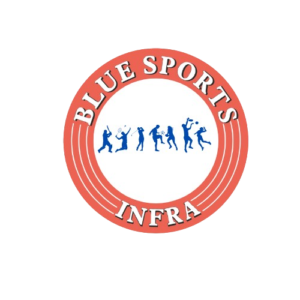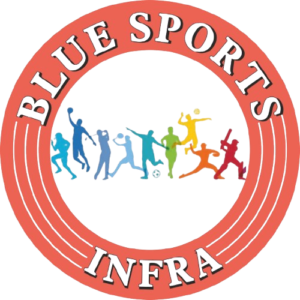Synthetic turf has revolutionized how we view sports fields and residential landscaping. Its low maintenance appeal and year-round greenery make it a smart investment for both commercial and private use. However, to ensure your artificial grass lasts as long as it should—often 10-15 years or more—you need to give it proper care. At Blue Sports Infra, a leading name in the sports infrastructure industry, we’ve seen synthetic turf perform at its best when maintained properly.

One of the most important steps in synthetic turf maintenance is regular brushing. Over time, the artificial turf blades may begin to lean or flatten due to foot traffic. Using a stiff bristle brush to groom the turf restores its natural appearance and prevents matting. Especially in high-traffic areas like football fields or playgrounds, this simple step helps extend turf longevity and enhances performance.
Another crucial aspect is removing debris. Leaves, twigs, and litter can accumulate and lead to mold or drainage issues. A leaf blower or plastic rake works well without damaging the turf surface. If you’re using synthetic turf for a sports field, keeping it clean is especially critical for both safety and appearance. As experts at Blue Sports Infra advise, regular turf cleaning helps keep your field game-ready.
Water may not be needed for growth, but occasional rinsing is still important. Especially in warmer climates, synthetic turf can gather dust or residue. Rinsing with water not only freshens up the surface but also keeps it cooler, improving the player experience during summer games. For those using pet-friendly artificial grass, weekly rinsing helps eliminate odor and bacteria buildup, keeping your yard sanitary and odor-free.
Stain removal is another maintenance area that shouldn’t be overlooked. Food spills, grease, or even paint can stain the synthetic turf. Quick action with mild soap and water is usually effective. For tougher stains, specialized artificial grass cleaners are available. At Blue Sports Infra, we always recommend choosing non-toxic, eco-friendly products to protect the environment and your turf’s integrity.
Occasionally, you may need to top up the infill material. This granulated layer helps support the turf fibers and provides cushioning. Depending on the usage—be it a soccer pitch or a backyard putting green—monitoring and replenishing infill ensures optimal surface performance and reduces wear and tear. Professionals like Blue Sports Infra can inspect your synthetic turf system and advise on the best infill levels.
In regions where snowfall is common, it’s important to know how to handle winter care. Avoid metal tools that can damage the surface, and let snow melt naturally when possible. If removal is necessary, use a plastic shovel or snow blower with care. This is especially vital for commercial synthetic turf fields, which need to stay in playable condition year-round.
Synthetic turf maintenance doesn’t require the same labor as natural grass, but it does demand consistency. Following these best practices not only preserves the turf’s appearance but also maximizes your investment. Whether you’re maintaining a sports field, rooftop turf, or residential lawn, partnering with a trusted industry leader like Blue Sports Infra ensures long-term performance.
After all, the right upkeep turns a good turf installation into a great one—both in looks and lifespan.

